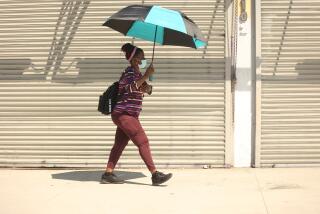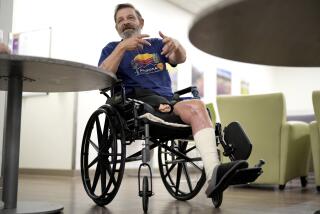For a Safe Season in the Sun, Supervise the Kids
- Share via
With the first day of summer still visible in our rearview mirror, it’s important for parents to renew their vigilance in watching their children. The single most important act to follow this summer--and during other seasons as well--is supervision.
Don’t assign kids to watch kids. Unless you know for a fact that the individual is responsible beyond his or her years, don’t rely on anyone younger than 16 to be responsible for your child’s safety.
With the onset of warm weather, and school being out for the summer, emergency rooms all over the Southland will begin to see an all-too-familiar variety of illnesses and injuries. The truth is, those of us who work in emergency rooms would be much happier if all we had to do every day was stand around and not treat seriously injured children. But the sad reality is that we are very busy, especially during the warm-weather months.
Perhaps these tips will prevent a few mishaps, and maybe even save a few lives.
Falls
We see an unusual number of injuries due to falls of one kind or another. Whether it is a fall from an irresistible tree that had to be climbed, a roller-blading accident, or a fall from a two-story window or balcony, the results can be long-term and tragic.
Parents must remember that most window screens won’t support the weight of even a small child. When the weather gets warm, if you don’t have air-conditioning and feel you have to open the window for relief, please make certain you place some type of solid barrier in front of the window to prevent a toddler or infant from falling out of the window.
The comment we hear most often from parents or guardians is, “I only turned away for a moment.” That’s all it takes.
Make certain that your child, when participating in any activity, is wearing any and all appropriate safety equipment such as helmets, elbow pads and kneepads, and wrist protectors.
Likewise, helmets are not just a good idea when bicycling, it’s the law in California. Every year, about 400,000 children, age 14 and younger, are treated in emergency rooms for bicycle-related injuries.
Remember, kids take chances. Often they are injured while responding to a dare from a friend. So when you can’t be there to remind them how risky it might be, at least make certain your child is protected, despite peer pressure to the contrary. If your child does suffer an accident from a fall, parents should watch for the following:
* Unresponsiveness
* Loss of consciousness
* Drowsiness
* Persistent or intermittent sleepiness
* Repetitive vomiting
* Confusion
* Combativeness
If any of these symptoms exist, get your child to an emergency room as soon as possible.
Water Accidents
Children can drown in the time it takes you to answer your telephone. Whether it’s at the beach, a lake, in a bathtub or in your own backyard swimming pool, drowning is the leading cause of accidental death in California in children younger than 5. Last year, about 3,000 kids in the United States were treated in hospital emergency rooms following near drowning or submersion injuries. This is particularly tragic because it’s entirely preventable. Supervision!
There are four simple rules parents should stress to their children:
* Always swim with a responsible friend, never alone.
* Don’t dive into unmarked or unfamiliar water; wade in first.
* Don’t push or jump on other people.
* Always be prepared for an emergency.
There are other precautions you can take such as completely fencing your pool or spa, install a self-closing and self-latching gate, position latches out of the reach of children, keep all doors and windows leading to the pool area secure, and keep toys away from the pool area because young kids may fall in accidentally while playing around the pool.
Do not consider your child “drown proof” because he or she has had swimming lessons. It would be a good idea for all adults and older children in the family to learn basic first aid and CPR. You never know when you might be the only one around who can provide the necessary life-saving measures until help arrives.
The Sun
Anyone can get sunburned in less than 30 minutes. Even if it’s overcast, the sun’s rays can burn the skin.
Always make sure you and your children use sunscreen with an SPF rating of at least 15. And remember to apply it 20 minutes before going into the sunlight, and then reapply it frequently, despite what the directions on the container might say.
Sunscreen can wash off with sweat, through prolonged exposure to the water, or while wrestling around on the grass or carpet. And be sure to apply it to every area that shows, even the scalp. We have seen cases in which children brought to the emergency room appear fine except for the top of their heads, which were bright red and badly burned.
Other sun safety tips include:
* If possible, avoid the sun from 10 a.m. to 3 p.m. The sun’s rays are the strongest during this time.
* Wear a visor or hat, tightly woven clothing and sunglasses.
* Keep infants younger than 6 months of age out of direct sunlight altogether. Use a stroller or umbrella.
* Remember “Slip, slop, slap”--slip on a shirt, slop on sunscreen and slap on a hat.
* Exposure to the sun also can cause heatstroke. Be sure that you and your kids drink plenty of fluids with low-sugar content.
* Avoid plain water because it can wash out your body’s necessary salts and might lead to seizures.
* Drink juices with balanced salt and sugar (e.g., Gatorade or similar products).
* If your child has been out in the sun for a prolonged period of time, make sure he or she is urinating a normal amount.
* And if they cry, be certain you actually see tears. If not, they may be dehydrated.
And remember, the single most important thing a parent can do to protect a child is supervise!


